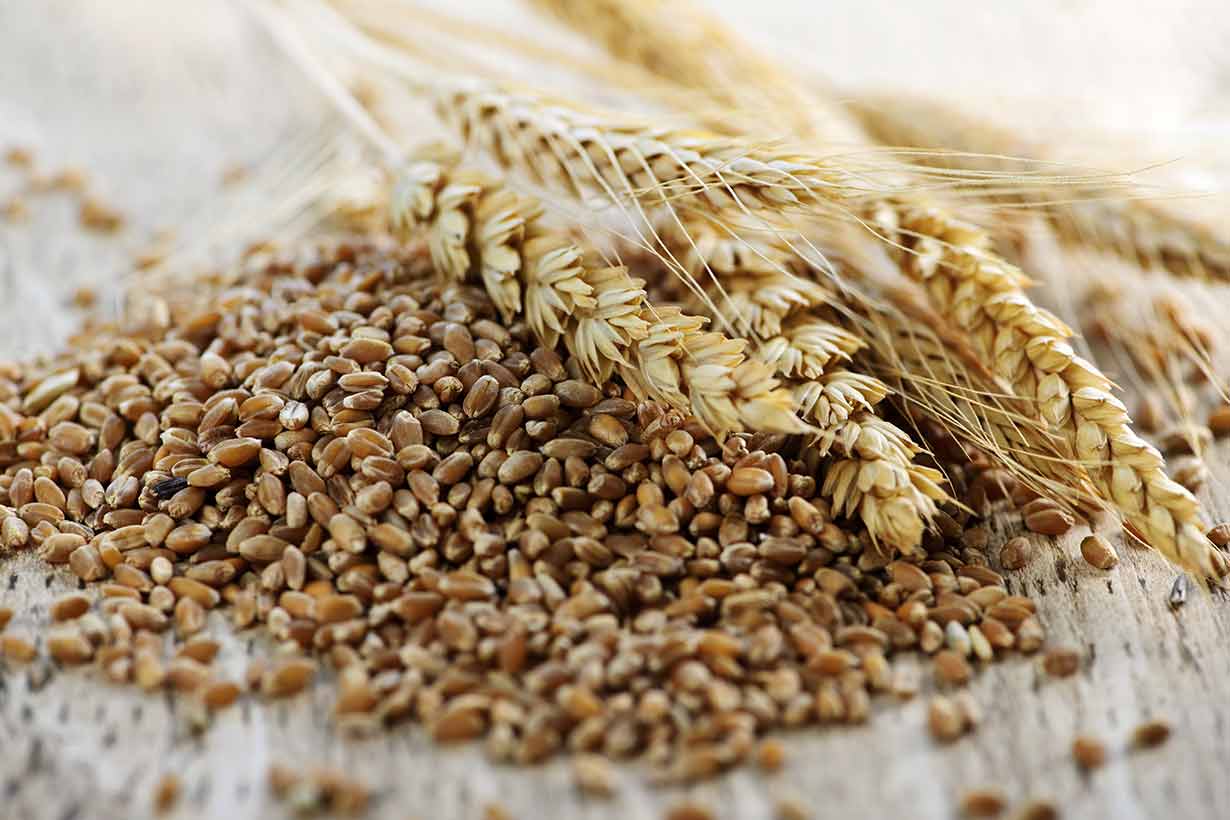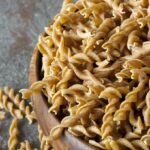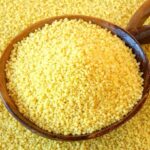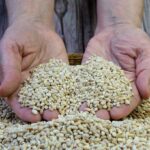Wild rice is a whole grain from species of plants in the genus Zizania.
It is commonly positioned as a healthier alternative to white rice and has grown in popularity in recent years.
However, what does wild rice offer nutritionally, and how does it compare to white rice?
This article provides a complete guide to the nutritional properties of wild rice and its potential benefits and downsides.
Table of contents
What nutrients does wild rice provide?
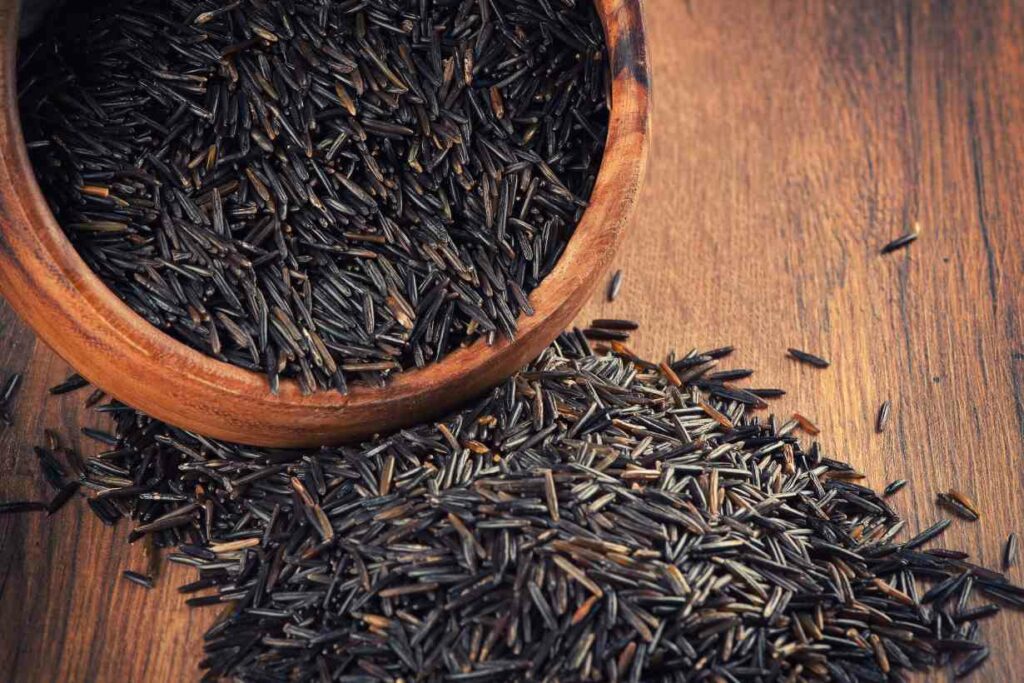
Firstly, here is the complete nutritional profile of wild rice per 164-gram cup serving.
The nutritional values are for ‘cooked’ weight; the data source is the USDA’s FoodData Central database (1).
Daily values (% DV) have been calculated using USDA data and the FDA’s published daily values (2).
| Name | Amount | % Daily Value |
|---|---|---|
| Calories | 166 kcal | |
| Carbohydrates | 34.9g | 12.7% DV |
| Fiber | 2.95g | 10.5% DV |
| Sugars | 1.2g | |
| Fat | 0.56g | 0.7% DV |
| Saturated | 0.08g | 0.3% DV |
| Monounsaturated | 0.08g | |
| Polyunsaturated | 0.35g | |
| Omega-3 | 0.16g | |
| Omega-6 | 0.19g | |
| Protein | 6.54g | 13.1% DV |
| Cholesterol | 0mg | 0% DV |
As we can see, wild rice is primarily a source of carbohydrates and contains a moderately high amount of fiber.
It contains a moderate amount of protein and has minimal levels of dietary fat.
For anyone looking for a rice-like grain with high protein, refer to this nutritional guide to freekeh.
Vitamins
| Vitamin | Amount | % Daily Value |
|---|---|---|
| Choline | 16.7 mg | 3% DV |
| Folate, DFE | 42.6 mcg | 10.7% DV |
| Vitamin A, RAE | 0 mcg | 0% DV |
| Vitamin B1 (thiamin) | 0.09 mg | 7.5% DV |
| Vitamin B2 (riboflavin) | 0.14 mg | 10.8% DV |
| Vitamin B3 (niacin) | 2.12 mg | 13.3% DV |
| Vitamin B5 (pantothenic acid) | 0.25 mg | 5% DV |
| Vitamin B6 (pyridoxine) | 0.22 mg | 12.9% DV |
| Vitamin B12 (cobalamin) | 0 mcg | 0% DV |
| Vitamin C | 0 mg | 0% DV |
| Vitamin D | 0 mcg | 0% DV |
| Vitamin E | 0.39 mg | 2.6% DV |
| Vitamin K | 0.82 mcg | 0.7% DV |
Table 2 shows that wild rice provides a good source of folate and several B vitamins.
Minerals
| Name | Amount | % Daily Value |
|---|---|---|
| Calcium | 4.92 mg | 0.4% DV |
| Copper | 0.20 mg | 22.2% DV |
| Iron | 0.98 mg | 5.4% DV |
| Magnesium | 52.5 mg | 12.5% DV |
| Manganese | 0.46 mg | 20% DV |
| Phosphorus | 134 mg | 10.7% DV |
| Potassium | 166 mg | 3.5% DV |
| Selenium | 1.31 mcg | 2.3% DV |
| Sodium | 4.92 mg | 0.2% DV |
| Zinc | 2.2 mg | 20% DV |
The mineral composition of wild rice includes high levels of copper, manganese, and zinc.
Other minerals present in moderately high amounts include magnesium and phosphorus.
How does wild rice compare to white rice?
Since people use white rice more commonly than wild rice, how do the two compare nutritionally?
The table below shows the basic nutrition facts for cooked wild rice versus long-grain white rice per cup serving (1, 2, 3):
| Name | Wild Rice | % DV | White Rice | % DV |
|---|---|---|---|---|
| Calories | 166 kcal | 205 kcal | ||
| Carbohydrates | 34.9g | 12.7% DV | 44.6 g | 16.2% DV |
| Fiber | 2.95g | 10.5% DV | 0.63 g | 2.3% DV |
| Sugars | 1.2g | 0.08 g | ||
| Fat | 0.56g | 0.7% DV | 0.44 g | 0.6% DV |
| Saturated | 0.08g | 0.3% DV | 0.12 g | 0.6% DV |
| Monounsaturated | 0.08g | 0.14 g | ||
| Polyunsaturated | 0.35g | 0.12 g | ||
| Omega-3 | 0.16g | 0.1 g | ||
| Omega-6 | 0.19g | 0.02 g | ||
| Protein | 6.54g | 13.1% DV | 4.25 g | 8.5% DV |
| Cholesterol | 0 mg | 0% DV | 0 mg | 0% DV |
Table 4 shows that white rice contains more carbohydrates and overall calories than wild rice.
Despite this, wild rice has a significantly higher fiber and protein content.
Micronutrient (vitamin and mineral) comparison
The following table shows the top five vitamins and minerals present in the highest quantities in wild rice and white rice (1, 2, 3):
| Wild Rice | Amount | White Rice | Amount |
|---|---|---|---|
| 1. Copper | 0.20 mg (22.2% DV) | 1. Selenium | 11.8 mcg (21.5% DV) |
| 2. Zinc | 2.2 mg (20% DV) | 2. Vitamin B5 | 0.616 mg (12.3% DV) |
| 3. Vitamin B3 | 2.12 mg (13.3% DV) | 3. Copper | 0.11 mg (12.1% DV) |
| 4. Vitamin B6 | 0.22 mg (12.9% DV) | 4. Vitamin B6 | 0.147 mg (8.6% DV) |
| 5. Magnesium | 52.5 mg (12.5% DV) | 5. Zinc | 0.774 mg (7.0% DV) |
As Table 5 shows, wild rice tends to have a higher concentration of vitamins and minerals.
Furthermore, wild rice typically has a higher relative amount of most vitamins and minerals than white rice.
What benefits does wild rice have?
Based on scientific research findings, here are some additional benefits that wild rice may offer.
Switching to wild rice can significantly increase nutrient intake
Researchers behind a 2022 study analyzed the essential nutrient profiles of different types of rice sold in the United Kingdom.
Based on a total of fifty-five rice samples, the results of this analysis found that (4, 5):
- Switching from white rice to wild rice “could increase the intake of several essential nutrients by up to eight times that of white rice.“
- Among these greater nutrient provisions, the concentration of phosphorus, potassium, and magnesium in wild rice was significantly higher than in white rice. The mean difference was that wild rice offered 2-3 times higher amounts.
For more on the properties of rice varieties, see this nutritional guide to the different types of rice.
Wild rice has a lower glycemic index than white rice
Based on a score out of 100, with 100 being the score of pure glucose, the glycemic index predicts how much a specific food will raise blood sugar levels.
On this note, white rice is among the highest-rated foods on the glycemic index. For example, the international tables of glycemic index and glycemic load values 2021 shows that white rice has a glycemic index of 73 (5).
In comparison, according to the University of Sydney’s glycemic index research database, wild rice has a glycemic index of 58 (6).
In this regard, whole grains such as wild rice, whole wheat, and barley have lower blood sugar responses than refined carbohydrates like white rice and white flour (7).
Wild rice contains a range of bioactive polyphenols
Phytonutrients are bioactive compounds found in plants capable of having a biological effect on the body.
Many of these compounds, such as polyphenols, are thought to have health-protective properties against chronic disease (8, 9).
Several pieces of research have investigated the phytonutrient profile of wild rice.
These studies show that wild rice contains far higher levels of phytonutrients than white rice. Additionally, some of the most concentrated compounds found in wild rice include (10, 11, 12, 13):
- Anthocyanins
- Chlorophyll
- Flavonoids
- Phenolic acids
- Phytosterols
- Saponins
Does wild rice have any downsides?
One of the most common concerns about wild rice is its potential contamination with heavy metals.
Wild rice can contain heavy metals like arsenic and lead
Research demonstrates that samples of wild rice can have elevated levels of arsenic and lead (14, 15, 16, 17).
Arsenic and lead are heavy metals that can build up in the body over time, potentially leading to health issues. For instance, arsenic is a class 1 human carcinogen, meaning that it may contribute to cancer development (18).
However, it is worth noting that this problem is not unique to rice. Other foods have also been found to contain elevated levels of these heavy metals, including leafy vegetables and chocolate/cocoa products (19, 20).
We also have to balance potentially problematic compounds in food with the beneficial nutritional properties of that food.
Heavy metal content may warrant further investigation if relying on wild rice as a daily staple, but it shouldn’t be problematic for the typical diet. Consuming a varied diet and incorporating other foods rather than exclusively relying on wild rice should limit these potential downsides (21).
Wild rice tastes different from white rice
Despite the higher nutritional values of wild rice, it has a stronger, earthier taste and a chewier texture than white rice.
Many people prefer the relatively soft texture and mild taste of white rice.
Common Questions About Wild Rice
To help summarize this guide to wild rice, here are some answers to people’s typical questions about wild rice.
Wild rice offers more fiber, protein, and essential micronutrients than white rice for fewer calories. So in this sense, we can say that it provides a better nutritional profile.
Table 4 of this article shows that a cup serving of wild rice contains 39 fewer calories than white rice. All else being equal, this could be a total calorie difference of 2000 calories per year if rice was consumed once per week on average. However, no particular food is uniquely “good for fat loss,” and this depends on the overall dietary pattern.
Both wild rice and brown rice offer more in terms of nutrients per gram than white rice. Overall, the two are pretty similar in their nutritional content. A 2022 study conducted in the United Kingdom examining different types of rice found that wild rice was the best source of iron and zinc. However, brown basmati rice had a slightly higher overall nutrient content (4, 5).
Final Thoughts
This article shows that wild rice offers more nutritional value than white rice.
For those who enjoy the taste of wild rice, it may be a smart substitute that can increase dietary nutrient intake.

